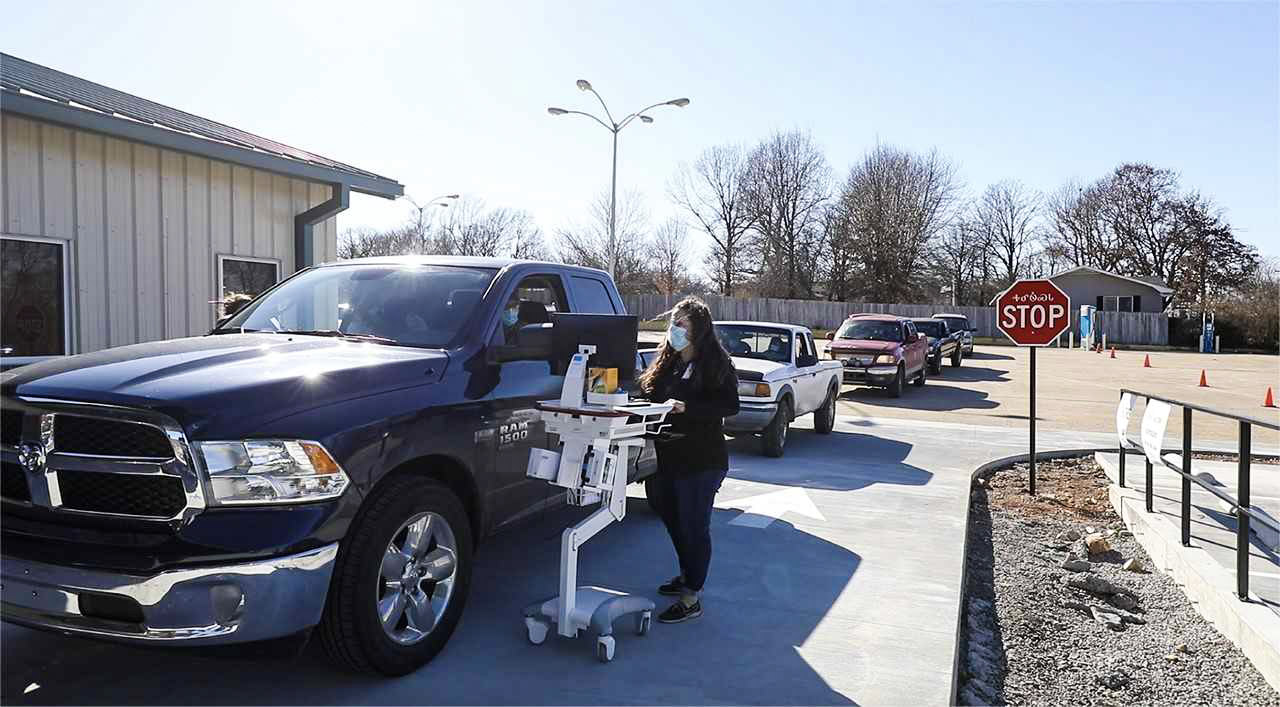
Reed acknowledged that the weather interfered with the vaccination timeline but said “we’ll be able to make up for lost time pretty easily.” The intense winter storms and power outages have slowed the administration of vaccines at more than 2,000 sites nationwide, and more than a third of states are experiencing shipment delays. Some people are worried about the effectiveness of the vaccine if their second-dose appointments get pushed back because of the weather. Reed said that according to the Centers for Disease Control and Prevention, there is no evidence of a decrease in the vaccine’s effectiveness as long as the second dose is within 42 days of the first. There is no data on its effectiveness after 42 days, but if a second-dose appointment gets pushed beyond that, the CDC recommends getting the next dose as soon as possible, and not repeating the first dose.Despite challenges posed in remote regions of Indian Country, the Indian Health Service is outpacing many states with its #COVID19 vaccination efforts, working with tribes to reach as many people as possible. #Coronavirus @IHSgov https://t.co/I2OmDat193
— indianz.com (@indianz) February 26, 2021
Since the first coronavirus vaccination in the state in December, thousands of Oklahomans have received the completed series of vaccine doses. As of February 18, the latest data available, 22.7% of Oklahoma adults had been vaccinated with at least the first dose. Reed said the state is expecting to receive 110,000 doses any time and an additional 137,000 next week. “We’ve (already) probably vaccinated 45 to 50% of our population of patients 65 and older with at least one dose of the vaccine,” said Dr. Dale Bratzler, a leading infectious disease expert at the University of Oklahoma hospitals. “They account for more than 70% of the hospital admissions in Oklahoma, and they account for more than 80% of the deaths from COVID-19.” Based on the Census Bureau’s 2019 population estimate, Oklahoma’s adult vaccination rate of 22.7% is better than in some adjacent states. In Texas – where severe weather compelled the state to implement rolling power outages to reduce stress on the electric grid – about 19.86% of the state’s adult population has been vaccinated. Kansas has vaccinated 14.66% of adults, and Arkansas about 19.68%. In Colorado, more than 1 million vaccines have been administered to a population of more than 5 million, about 24.09% of the population. In Mississippi, 20.3% of adults have been inoculated. And in New Mexico, an estimated 28.73% of adults have received at least one dose of the vaccine. All 39 Indigenous nations in Oklahoma opted to receive the vaccine through the federal Indian Health Service rather than the state. “Tribal nations have been a key part of our planning for the vaccine rollout so that American Indians and Alaska Natives will have equitable access to safe and effective COVID-19 vaccines,” the Oklahoma City IHS office reported. “As of Feb. 12, the Oklahoma City Area Indian Health Service, which serves tribes in the state of Oklahoma, has distributed 209,225 COVID-19 vaccines to the tribal health programs.” Buffy Heater, assistant deputy commissioner for the state health department, said the state’s Immunization Information System only collects state-allocated vaccine data, which includes American Indians who were vaccinated at county health departments and private health care providers and hospitals that administer the vaccine. The Indian Health Service shares its vaccination data with the CDC rather than Oklahoma or any other state. With no direct communication, the state is unable to obtain those records easily. That’s why tribal vaccine numbers are not typically included in Oklahoma’s statewide reports, Reed said.UPDATE: Over 1 million COVID-19 vaccine doses administered in Oklahoma, according to CDC. The CDC’s online vaccine tracker recently added federal doses administered to each state’s total count, allowing OSDH to have visibility into this data for the first time. (1/2) pic.twitter.com/8wmVD6DmXk
— OK Dept of Health (@HealthyOklahoma) February 26, 2021
The response was so swift that appointment slots for the 10,000 doses at the free clinic were filled up within 20 minutes. Bratzler called it a promising sign that people are listening and signing up for immunizations. “We’re in a bit of a race right now to get as much vaccine out there that we possibly can to slow the current spread, because if you slow spread you reduce the opportunities of mutation,” Bratzler said. “When you get the opportunity to get the vaccine, unless you have a specific contraindication, please get the vaccine. It’s the best way to protect yourself. It is our pathway to getting back to the norm we used to remember.”The February 2021 Issue of the Biskinik is now available to view online. In this issue, the arrival of the COVID-19 vaccines within the Choctaw Nation is highlighted. View this article and more at https://t.co/7sOezGLSZ3. pic.twitter.com/7Cz3bEBn6E
— ChoctawNationOK (@choctawnationOK) February 8, 2021
Gaylord News is a reporting project of the University of Oklahoma Gaylord College of Journalism and Mass Communication. Cronkite News has partnered with OU to expand coverage of Indigenous communities.
For more stories from Cronkite News, visit cronkitenews.azpbs.org.
Haskell Faculty: Trail of broken treaties continues with mass terminations at tribal college
Georgia Recorder: Judge extends hold on President Trump’s funding freeze
Native America Calling: Traditional Indigenous instruments
Bureau of Indian Affairs turns to new technology to help solve missing and murdered cases
Native America Calling: Tribal broadcasters brace for federal funding fight
Native America Calling: Assessing current health threats to Indian Country
‘I am finally going home’: Leonard Peltier released from prison after nearly five decades
NAFOA: 5 Things You Need to Know this Week (February 18, 2025)
Chuck Hoskin: Cherokee Nation supports our artists
Native America Calling: Native activism marks victory with Leonard Peltier’s release
Native America Calling: What Indigenous people in Greenland really want
Native America Calling: Traditional love stories
RECAP: National Congress of American Indians continues big meeting in DC
Native America Calling: Honoring artists who demonstrate community spirit
More Headlines